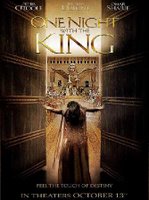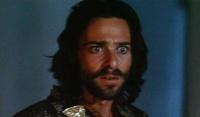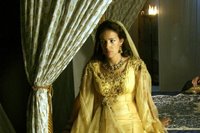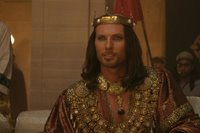Queen Esther (1948)
About 6 years ago I mentioned that the Gospel Films Archive were hoping to release a DVD of the 1948 Cathedral Films production Queen Esther. It's been a longer wait than any of us expected, but I was really excited this week to get an email from them informing me that the restoration work on the film has finally been completed and it's now available to buy on DVD alongside the 1937 biblical film, Ruth which I'm yet to see1 Here's my brief review of what I think is quite an important work, given the general of paucity of US biblical films in the 20 year prior to its release.
=====
Esther has often been a popular choice for Jewish and Christian artists working in an array of media over the decades. The patriarchal succession for Israel and Judah meant that biblical queens have tended to only been involved in the royal families by marrying into them, and of those few to get anything more than a cursory mention, often they are seen as having a negative influence rather than a positive one.
Esther, though, is distinctly different. As a Jewish woman who gets elevated to be a queen in the Persian Empire. Not only does her story have excitement and glamour built into it, but she is also given a heroic role that she can fulfill by being faithful to God. No surprise, then, that during that first big crop of films based on the Hebrew Bible from 1908 to 1913, Esther got her movie debut in 1910 (Esther and Mordecai & The Marriage of Esther) and that by the end of the decade her story had graced the silver screen seven times.
Yet by the time Cathedral films released Queen Esther in 1948 it had been almost three decades since her story had been made into any kind of film. As such it's the first Esther film to feature sound and one of the rare American Bible films from the period from the Great Depression to the immediate aftermath of the Second World War.
Interestingly the film starts in a modern setting with a Jewish family reading the Bible as part of celebrating Purim and using her Jewish name Hadassah. This framing of the story as a Jewish story is quite remarkable given its age, but perhaps just three years after the horrors of the Second World War the resonances between Haman's attempted destruction of the Jews and Hitler's were unavoidable. Indeed when we return to this family at the conclusion of the film the family's patriarch ("Grandfather") reminds them that "throughout the centuries there have been many who have attempted to destroy our people..."
By the time the story transitions to Ancient Persia then Esther has already married the Persian king, here identified as by the Greek version of his name Xerxes (rather than Ahasuerus).
Esther, played by Ottilie Kruger, is also identified as Mordecai's cousin. The opening scene is fictional and, somewhat bizarrely,2 features Mordecai (Richard Hale) explaining to Esther that those who approach her husband without permission risk being condemned to death. There's also an additional episode where Haman (Addison Richards) tries to convict one of Mordecai's associates of stealing from him, only for Mordecai to outwit him. While it remains an implication, it certainly is implied that Haman is acting dishonestly. It also firmly establishes that Mordecai is the kind of brave, forthright, quick-witted person whose character will be used to heroic effect later on.
Only then do we come across the first biblical episode from Esther 2:19-23 where Mordecai overhears a plot to kill the king, tells Esther who informs one of the kings advisors meaning the plot is foiled. Xerxes (Charles Evans) assumes this is Haman's work, but the official involved makes sure that it's recorded in the annals that it was Mordecai who was responsible for saving the king. But the official continues in his conversation with the scribe. It's clear that even a (presumably) neutral Persian considers Haman a bit iffy.
It turns out though that really this official should be more concerned about Haman's wife (pictured below) than he himself. Following Mordecai's refusal to bow before Haman, it is she who comes up with the idea to kill all the Jews and then urges Haman to do it. "It's beneath your dignity and rank to avenge yourself against one man. If all the Jews refuse to pay homage, let them all suffer"
Later she will also suggest building some gallows for Haman to have Mordecai executed. I'm not sure if this is the impact of film noir and its femmes fatale, but its strange to shift the blame from the villain in the text to another when no motive is particularly apparent.
Xerxes seems to have a rather laissez-faire attitude to Haman's authority which makes him somewhat unsympathetic. Nevertheless, Mordecai is very positive about his emperor's character, even calling him "Good King" when he is not around, stressing that "the king is not unkind, not unreasonable". Even when Haman's plan becomes apparent Mordecai is unable to blame the king. "It's evident that our good king has been misled". What's interesting is that (thankfully) there's no real attempt to present Xerxes as a romantic figure to whom Esther is drawn, something that is bolstered by the opening of the story being excised. But then in some ways this is because Mordecai is almost more of the focus in this film than Esther herself.
For a low budget production the sets are pretty good. I can't speak to their authenticity, though as with The Story Esther (1910) there are suggestions of the bas-reliefs in Haman's house and Xerxes' palace. The exteriors seem pretty good too. Likewise I don't know enough about the costumes of this time and place to be able to pronounce on their authenticity, (Haman wearing trousers) but they do seem to be more distinctive and of better quality than in some of the other releases by Cathedral Films.
There's the occasional nice use of the camera too. As many of the shots are fairly static the more dynamic shots – such as the pivotal scene when Esther risks all to request a dinner date with Xerxes and Haman – stand out all the more. The eve of the second banquet finds neither Esther nor Xerxes able to sleep, leading Xerxes to discover Mordecai's heroics meaning Haman's spends the day before the banquet leading Mordecai around the city to be honoured.
I always feel with the Esther story that the protracted stages with which Esther makes her request doesn't really translate very well dramatically. Here the film takes steps to make that seem less awkward while maintaining the original three-request structure of the original text. The first banquet follows immediately after her shock appearance in the courtroom and is very short: As with the Bible, Haman arrives at the second banquet hot on the heels of his day honouring Mordecai finally arrives.
It's interesting, though, how director John T. Coyle has subtly altered the seating arrangement. Esther sits to the left of the frame in both scenes, but in the first she sits next to Xerxes, literally getting him on-side: In the second, now Haman sits between the king and his wife, as if underlining the fact that his schemes threaten to separate king and queen permanently. Esther seizes her moment when Haman proposes a toast to the royal couple's reign "may it be a long, prosperous and happy one", opting out of the toast and then, when pressed by Xerxes, explaining her predicament. Xerxes is angered. Haman exposed. Xerxes orders that Haman and his sons be hanged on their own gallows and promises Esther that he will find a way to save them.
It's here that the film cuts back to the film's modern book-end. The extent to which the Jewish people fought back (killing over 75,000 of their enemies) is doubly watered down here. Firstly, no scenes of this violence are depicted, but also when instead the "Grandfather" (played, I think, by the same actor as Mordecai) narrates the end of the story his rather child-friendly summary is that "they defended themselves so valiantly, their enemies were discouraged".
For those familiar with Cathedral Films' other efforts, particularly The Great Commandment (1939), No Greater Power (1942), I Beheld His Glory (1952) and Day of Triumph (1954), this film is more or less what one might expect. The story holds fairly closely to the biblical story, with the most significant variations being being the point at which the story dips in and out of the original text, often using some kind of framing device. The costumes and sets look good value for the low budget and the acting is to a better standard than similar church produced films in the era. While, like nearly all Esther films, it makes certain elements of the story more palatable and family friendly, at least it doesn't take things in the opposite direction of making it a love story. And of course the kind of more incisive interrogation of the text that that we might give it today was not remotely on the agenda in 1948.
What was on the agenda back then is reflection on the Holocaust and it's here where the film is most powerful and creditable. Its framing of this as a Jewish story and a reminder that persecution of Jewish people has been an ongoing aspect of history, not a one off, seems unprecedented to me, even with biblical films from the post-war period. It's even more remarkable given its the product of an unashamedly church-based producers and deserves to be seen more widely.
==============
1 - I haven't been paid to endorse this film though I did receive a screening link. I don't even make money via Amazon affiliate links: They're just convenient.
2 - I don't mean that the law permitting this is bizarre, even though it seems so to our eyes, more that it seems odd that Mordecai is explaining this to Esther only after she has married him and that this wasn't covered during the 12 months she was being institutionalized at court.
Labels: Cathedral Films, Esther


















































